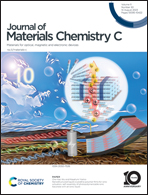Reduced open-circuit voltage deficit in wide-bandgap perovskite solar cells enabled by thiazolidine-based interfacial engineering†
Abstract
Highly efficient and stable wide-bandgap (WBG, 1.65–1.70 eV) perovskite solar cells (PSCs) are a vital part to fabricate high-performance perovskite-silicon tandem solar cells. Herein, we propose an interfacial engineering strategy to passivate the surface defects of WBG perovskite films by employing 1,3-thiazolidine hydrochloride (ThHCl). The ThHCl treatment improves the carrier lifetime of the WBG perovskite absorber, decreases the defect density, and lowers the dark saturation current density of the device, leading to decreased nonradiative recombination. As a result, compared with the open-circuit voltage (VOC) of 1.08 V for the control device, the device with ThHCl treatment delivers an improved VOC of 1.17 V, corresponding to a VOC deficit of 510 mV. Finally, a champion efficiency of 20.02% is achieved for the ThHCl-treated device with decent stability. The corresponding semitransparent device shows good near-infrared transmittance, beneficial to the construction of perovskite-silicon tandem solar cells. Our results demonstrate that thiazolidine-based interfacial engineering is a promising approach for achieving efficient and stable WBG PSCs.



 Please wait while we load your content...
Please wait while we load your content...